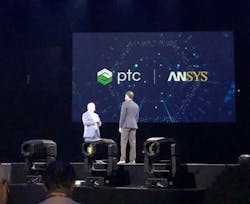On the heels of last week’s announcement between Rockwell Automation and PTC, which included Rockwell making a $1 billion equity investment in the software company, this week revealed yet another deal that will provide even more value for its manufacturing customers.
At PTC LiveWorx in Boston, the company, known for its 3D CAD software, announced a partnership with ANSYS, a maker of engineering simulation software.
Working together, ANSYS and PTC will integrate ANSYS Discovery Live real-time simulation within PTC’s Creo 3D CAD software. The combined solution will be sold by PTC as part of the Creo product suite, and provide customers with a unified modeling and simulation environment. The integrated products will remove the boundaries between CAD and simulation and enable design engineers to gain insight into each of the many design decisions they make throughout the product development process. This insight will enable engineers to create higher quality products while reducing product and development costs, company executives said at the conference this week.
“Our mission is to accelerate and expand the rate of innovation in design and manufacturing of physical things [through the] capture and analysis of data and the orchestration across digital systems,” said PTC CEO Jim Heppelmann during the opening keynote, noting that enabling people to participate more directly in the design iterations is also important.
Traditionally, simulation was done at the end of a design process to validate and verify the design without having to make a physical prototype. But simulation is now pervasive throughout the product lifecycle, and there is a need to use simulation early in the product design process to optimize manufacturing, especially with new technologies like 3D printing.
“With the combined solution, engineers will be able to see the real-time results of simulation during the modeling process, enabling them to understand design changes in their models,” Heppelmann said.
Now, with Creo and the simulation software integrated, every time a design change is made a new finite analysis generates so that the engineer knows exactly how the change will affect the design.
“This is a unique combination with a huge impact on the market,”said Ajei Gopal, president and CEO of ANSYS. “Eighty percent of product cost is locked in during the early crucial design phase. Now designers can innovate at the speed of thought. Engineers can try multiple options and creatively solve design challenges without product delays.”
The combined product will be released later this year and will complement the simulation technology built on PTC’s ThingWorx 8 Internet of Things (IoT) platform, which was announced last year along with other capabilities including anomaly detection, augmented reality and role-based intelligence.
“Companies can transform raw intelligence into actionable intelligence [creating] new opportunities to optimize operations and maintenance and integrate that back into future product development,” Heppelmann said. “This differentiates our CAD and IoT platforms in amazing ways.”
About the Author
Stephanie Neil
Editor-in-Chief, OEM Magazine

Leaders relevant to this article:
